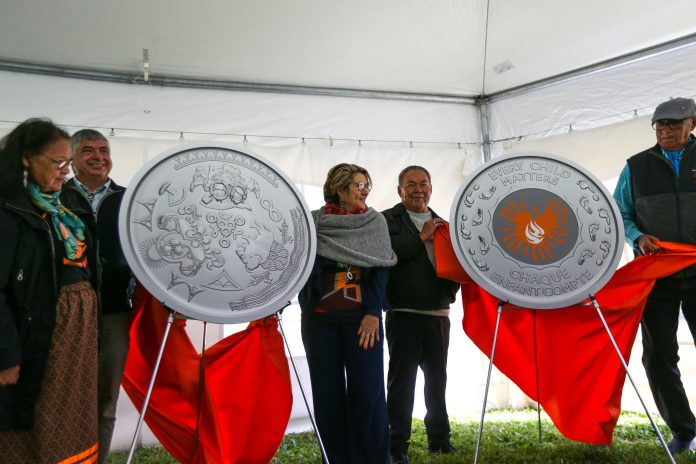
The National Centre for Truth and Reconciliation and the Royal Canadian Mint have together unveiled a deeply symbolic keepsake that acknowledges the truths behind the residential school experience on First Nations, Inuit and Métis children and their families, and supports our commitment to fostering reconciliation. Honouring the Survivors and children who never returned, the Truth and Reconciliation Keepsake helps educate Canadians about the intergenerational impacts of Residential, Day and Boarding schools. It invites reflection and conversation about the impacts of those schools, the conditions that created them, and how people living in Canada can turn reflection into acts of reconciliation.
“September and the National Day for Truth and Reconciliation is a moment for the country to pause, reflect, and remember the children who never came home from residential school and those still with us today,” said Stephanie Scott, Executive Director of the National Centre for Truth and Reconciliation. “People in Canada can now honour those children and Survivors with this keepsake, and support the healing journeys of our communities through the Na-mi-quai-ni-mak Community Support Fund.”
“Mint employees are proud to have worked closely with the National Centre for Truth and Reconciliation and its Survivors Circle to create the Truth and Reconciliation Keepsake,” said Royal Canadian Mint President and CEO, Marie Lemay. “We are deeply touched by the work of the First Nations, Inuit and Métis artists that Canadians can proudly display as they wear the keepsake to help bring the truth of residential schools to light and encourage fellow Canadians to join the journey towards reconciliation.”
Both sides of the keepsake feature richly symbolic imagery, reflective of First Nations, Inuit and Métis teachings and traditional art forms. Its design is the result of a unique collaboration between artists Leticia Spence (First Nations), Jason Sikoak (Inuit), JD Hawk (Métis) and Survivors to weave a thoughtful and compelling story of the Residential School experience for Indigenous communities across Canada.
On one side of the keepsake, the three artists created a collection of visual elements that form an expression of Indigenous cultures and perspectives. First Nations rights, culture and teachings are represented by the natural element of the sun and traditional teepee lodgings; a tikanagan (cradle board) held and supported by two people, as a symbol of connection and traditional family support across generations, this is also supported by symbols of water, and a stylized fireweed flower; and to the left, a triangular motif inspired by parfleche (a rawhide carrying bag) designs. The Inuit perspective is represented by traditional tattoo line work that was taken away by colonialists and is now coming back as a sign of pride; the northern lights that symbolize Inuit Nunangat and reflect the beauty of the North; a brother and sister—a representation of those who were sent to residential schools—facing the challenge that lies before them; and to the left, an ulu which is a traditional curved knife that is used in the North. The Métis Nation is represented by the Métis sash that signifies connection—to nature, to the past, to each other; a beadwork flower representing resilience amid thorns that signify pain and suffering; the bison, a symbol of strength and determination, bravely facing east to confront the approaching colonizers; and to the left, the infinity symbol that represents the joining of two cultures, First Nations and European, and their permanent existence as a people.
The other side of the keepsake bears messages of powerful significance: “EVERY CHILD MATTERS” is prominently inscribed in English and French. To the left and right, pairs of footprints, represent ancestors walking with younger generations. At the centre of it all, orange-coloured hand prints form the shape of the sun—the life-giving source of light and heat. Within the hands is the flame motif from the National Centre for Truth and Reconciliation logo, an acknowledgement of the spiritual flame that is born inside a person, while the hands are encircled by a border representing the radiating waves of the sun’s light and heat.
By ordering keepsakes for their family, friends, or colleagues, Canadians can humbly wear it as a way to signal that they stand with Survivors and remember the children who never returned. It symbolizes their commitment and willingness to both learning the truth, and carrying out acts of reconciliation. All net proceeds from the sale of the Truth and Reconciliation Keepsake will support the work of Na-mi-quai-ni-mak Community Support Fund, established by the National Centre for Truth and Reconciliation. This community fund assists Survivors and their communities carry out healing and commemoration activities.
Images of the Truth and Reconciliation Keepsake can be found here.







